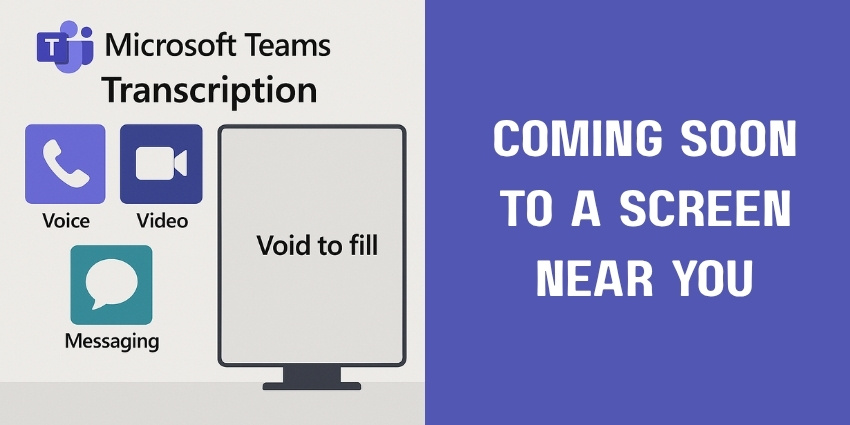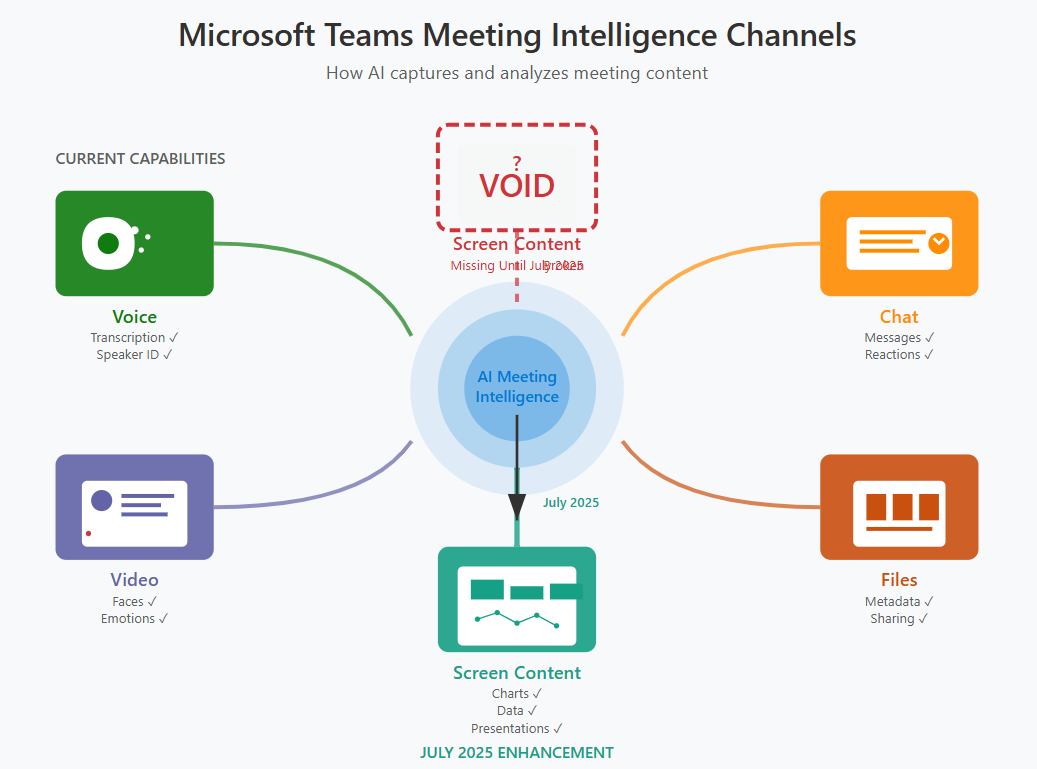As someone who’s spent countless hours in back-to-back virtual meetings, watching colleagues frantically scribble notes while trying to follow shared presentations, I’ve witnessed firsthand the frustration of incomplete meeting summaries. If you’re a business leader, IT professional, or anyone who relies on productive collaboration, Microsoft’s latest development is about to revolutionize how you capture and recall meeting content.
Microsoft has officially announced a breakthrough enhancement to Microsoft Copilot’s intelligent meeting recap that addresses one of the most glaring gaps in AI-powered meeting summaries: the ability to understand and analyze shared screen content. Set to roll out in July 2025, this is a major shift in how AI comprehends our collaborative workspace.
The Missing Piece Finally Found
According to Microsoft’s official roadmap (ID: 490052), the enhanced intelligent meeting recap will “incorporate content shared on screen in the AI-based summary provided after the meeting, providing a richer and more comprehensive recap.”
More importantly, it “captures details shown when a participant shares their screen, ensuring those unspoken insights become part of the meeting recap.”
This last point is crucial. How often have you been in a meeting where someone shares a complex dashboard, points to specific metrics, and says “as you can see here…” without actually verbalizing the numbers? Those unspoken but critical insights have been lost to traditional meeting summaries—until now.
Tom Arbuthnot from Empowering.Cloud perfectly captured this limitation during a recent Microsoft Teams news show:
Very often in meetings, we’re sharing decks and content and tables. And obviously, we see that as we’re collaborating. But in the summary, there’s no reference to that because right now, the AI doesn’t see the screen or have any context.”
Ryan Herbst from UnifiedCommunications.Com also shared his perspective:
This is more than a feature – it’s a foundational improvement. Meetings are not just about what we say and adding screen content to Copilot summaries transforms the recap into a truly comprehensive reflection of what happened, not just what was said.
The Intelligence Revolution: Capturing Visual Context
Starting July 2025, Microsoft Copilot will actively consume and analyze shared screen content across Desktop and Mac platforms, incorporating these visual elements directly into meeting summaries. This means your AI-generated recap will finally include references to:
- Key data points from shared spreadsheets that drove budget discussions
- Important slides from presentations that influenced strategic decisions
- Charts, graphs, and visual analytics that supported your conclusions
- Documents reviewed during the session, with specific details highlighted
- Any on-screen content that informed your team’s thinking
The feature will be available across Worldwide (Standard Multi-Tenant), GCC, and GCC High cloud instances, ensuring broad accessibility for organizations at all security levels.
Real-World Impact: Where This Changes Everything
For IT leaders managing complex technical discussions, this update means no more missing critical system diagrams or configuration details shared during troubleshooting sessions. When your team reviews network architectures or security frameworks on screen, the AI will capture these visual elements alongside the discussion, creating comprehensive knowledge transfer records.
Project managers will benefit enormously when reviewing project timelines, Gantt charts, or resource allocation spreadsheets during team meetings. Those moments when you point to specific milestones or budget line items will now be preserved in the meeting summary, ensuring nothing falls through the cracks.
Sales and marketing teams sharing competitor analysis, campaign performance dashboards, or market research presentations will finally have meeting summaries that capture the data behind their strategic discussions. The AI will understand which metrics sparked which decisions, creating a complete picture of your collaborative process.
The Compliance Challenge: A Growing Business Case for Unified Solutions
While this enhanced intelligence capability represents a significant productivity breakthrough, it also introduces new layers of complexity for compliance teams. Organizations now face the challenge of managing screen content data alongside traditional meeting transcripts, chat logs, and audio recordings across multiple platforms and tools.
Consider the regulatory implications: financial services firms subject to MiFID II requirements, healthcare organizations managing HIPAA compliance, or legal teams dealing with attorney-client privilege must now account for visual content captured during meetings. When sensitive financial data appears in shared spreadsheets, confidential patient information is displayed in medical dashboards, or privileged legal documents are reviewed on screen, all of this content becomes part of the permanent meeting record.
This complexity multiplies when organizations use fragmented UC ecosystems. A typical enterprise might have Teams for internal meetings, Zoom for client calls, Slack for team communications, and various third-party tools for specialized workflows. Each platform captures different types of data, applies different retention policies, and requires separate compliance management processes.
The result is a compliance nightmare: legal discovery requests now require coordinating across multiple systems to piece together complete interaction records. Retention policies become inconsistent across platforms. Data sovereignty requirements become nearly impossible to manage when meeting intelligence is scattered across different cloud providers and geographical regions.
This growing complexity makes an even stronger business case for fully unified compliance solutions. Organizations that consolidate their collaboration tools within Microsoft’s ecosystem gain centralized compliance management across Teams meetings, SharePoint documents, Exchange emails, and OneDrive files. When screen content analysis is added to this mix, everything remains within a single compliance framework with consistent data governance, unified retention policies, and streamlined legal discovery processes.
For compliance officers and legal teams, the ability to search across meeting transcripts, screen content, and related documents within a single platform represents enormous operational efficiency gains. Rather than managing compliance across multiple vendors with different data formats and legal processes, unified solutions provide comprehensive oversight and control.
The Premium Intelligence Experience
This enhanced screen content recognition comes as part of Microsoft Copilot (Microsoft 365), reflecting Microsoft’s strategy of positioning advanced AI capabilities within its premium collaboration suite. The investment in Copilot becomes increasingly valuable as these intelligent features address real productivity challenges rather than just adding technological novelty.
The feature represents a significant milestone in Microsoft’s vision of AI-powered workplace assistance that truly understands context, not just conversation. It’s part of a broader ecosystem that includes multi-agent orchestration, copilot tuning, and interactive meeting agents—all designed to make our collaborative tools genuinely intelligent rather than just functionally advanced.
Beyond Basic Transcription: The Future of Meeting Intelligence
This July 2025 update signals a fundamental shift in how we think about meeting documentation. We’re moving beyond simple transcription toward contextual understanding that mirrors how humans actually process collaborative sessions. When we discuss a presentation, we’re not just talking about abstract concepts—we’re engaging with specific visual information that informs our thinking.
The integration of screen content analysis also opens exciting possibilities for future enhancements. Imagine AI that can identify key decision points based on specific data visualizations, automatically flag action items related to particular spreadsheet cells, or even suggest follow-up questions based on presented content. The foundation Microsoft is building here supports a much more sophisticated understanding of how teams actually work together.
Preparing for Enhanced Intelligence
To maximize the value of this feature when it arrives in July, consider how your team currently shares visual content during meetings. Clear, well-structured presentations and documents yield better AI analysis than cluttered or poorly formatted materials. The quality of your screen content will directly impact the quality of your intelligent summaries.
Start establishing team standards for how information is presented during meetings. When your AI assistant can see and understand your shared content, the format and clarity of that content become crucial for generating useful insights and comprehensive summaries.
The Productivity Promise Delivered
This enhancement represents exactly the kind of AI advancement that delivers genuine productivity benefits rather than just technological showcase features. By addressing the screen content gap, Microsoft is solving a real pain point that affects millions of knowledge workers daily.
For organizations already invested in Microsoft’s collaboration ecosystem, this July update validates the strategic value of comprehensive UC platforms that continuously evolve and improve. Rather than managing multiple point solutions, you’re working within an integrated environment that becomes more intelligent and useful as AI capabilities advance.
As unified communications technology continues to evolve, we’re witnessing the transformation from simple communication tools to intelligent collaboration partners. Microsoft Copilot’s enhanced meeting recap isn’t just about better summaries—it’s about creating a digital workspace that truly understands how we work together.
Looking Ahead: The Intelligence Evolution
With the July 2025 rollout set for both General Availability and Targeted Release phases, organizations can begin planning how to leverage this enhanced capability. The feature’s inclusion in Microsoft’s official roadmap (last modified May 20, 2025) demonstrates the company’s commitment to delivering practical AI improvements that address real workplace challenges.
With screen content recognition coming to Microsoft Copilot, we’re moving toward a world where our meetings become not just more connected but genuinely more intelligent.
Ready to experience the next generation of meeting intelligence? Start preparing your team for July 2025 by exploring Microsoft Copilot and discovering how AI-powered collaboration will transform your productivity and decision-making processes.








